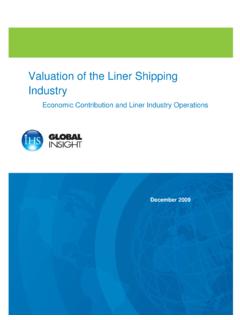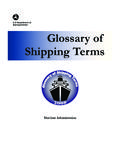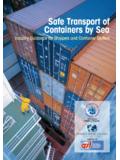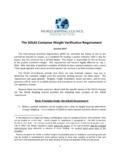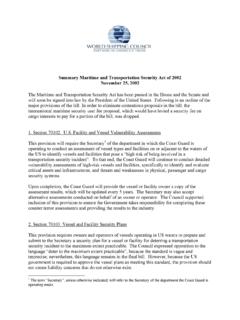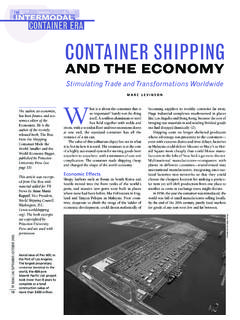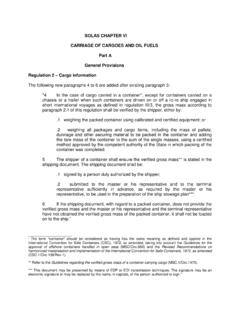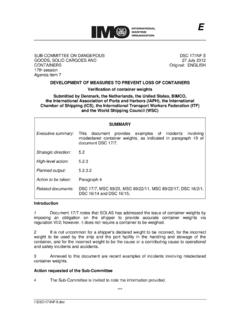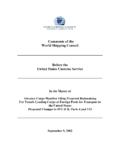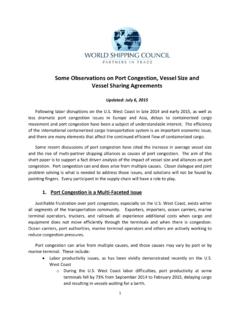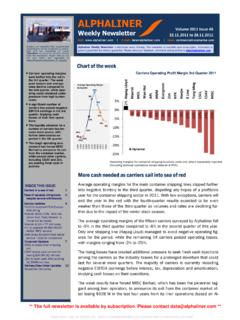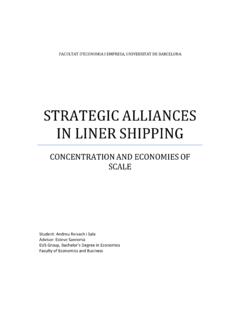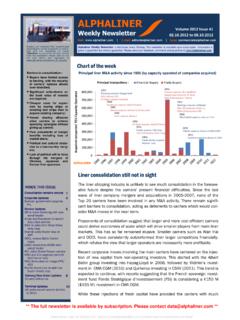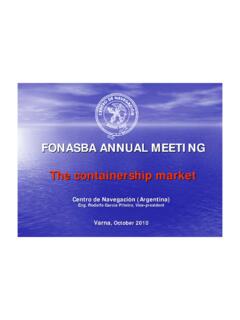Transcription of HT. 3754 – Review of the Consortia BER The Liner …
1 1 HT. 3754 Review of the Consortia BER The Liner Shipping Industry Supports the Commission s Proposed Extension of Commission Regulation (EC) No 906/2009 March 2014 The World Shipping Council (WSC), the European Community Shipowners Associations (ECSA), and the International Chamber of Shipping (ICS) respectfully submit these comments in response to the Commission s public consultation notice in matter Review of the Consortia BER. For the reasons set forth in more detail below, the shipping industry agrees with the assessment of the Commission that Commission Regulation (EC) No 906/2009 on the application of Article 81(3) [101(3)] of the Treaty to certain categories of agreements, decisions, and concerted practices between Liner shipping companies ( Consortia ) should be extended for an additional five years, until 25 April 2020.
2 Identity of the Commenters The World Shipping Council is a non-profit trade association, with offices in Brussels and Washington, , that represents the interests of the international Liner shipping industry in public policy and regulatory matters. WSC s twenty-nine member companies account for more than ninety percent of the world s Liner shipping capacity. ECSA is a non-profit trade association whose membership comprises the national shipowner associations of the European Union and Norway. ECSA s aim is to promote the interests of European shipping so that the industry can best serve European and international trade and commerce in a competitive free enterprise environment to the benefit of shippers and consumers. ICS is the global trade 2 association for shipowners with a membership comprising national shipowners associations in 36 countries, representing all sectors and trades and over 80% of the world merchant fleet.
3 1 Introduction In its proposed regulation to extend the period of application of Regulation (EC) No 906/2009, the Commission makes two important statements. First, the Commission has stated that: On the basis of the Commission s experience in applying the block exemption, it appears that the justifications for a block exemption for Consortia are still valid and that the conditions on the basis of which the scope and content of Regulation (EC) No 906/2009 were determined have not substantially changed. The second critical substantive assessment set forth in the draft Commission regulation published on 27 February 2014 is as follows: Regulation (EC) No 906/2009 simplified and introduced substantial modifications to the rules applicable to Consortia . Since the new legal framework has been in place and applied for only a short period of time, further changes should be avoided at this stage.
4 This will avoid increasing the compliance costs of the operators in the industry. The Liner shipping industry concurs with both of these assessments. In the comments that follow, WSC, ECSA, and ICS discuss the legal framework in which the Commission s assessments have been made, and we provide facts and analysis that demonstrate that the Commission s assessments and proposed course of action are correct. 1 The World Shipping Council s Transparency Register ID Number is 32416571968-71. Additional information about WSC and the Liner shipping industry is available at The European Community Shipowners Associations Transparency Register ID Number is 59004966537-01. Additional information about ECSA and its member associations is available at The International Chamber of Shipping s Transparency Register ID Number is 90104608462-14.
5 Additional information about ICS is available at 3 1. History and Rationale of the Consortia BER The Commission s current statement that the justifications for a block exemption for Consortia are still valid and that the conditions on the basis of which the scope and content of Regulation (EC) No 906/2009 were determined have not substantially changed is best understood within the context of the history of the Consortia BER. Beginning with Commission Regulation (EC) No 870/95, which was adopted by the Commission pursuant to the power granted to it by Council Regulation (EEC) No 479/92, the Commission has adopted a series of Consortia block exemption regulations, each effective for a period of five years. The current regulation, No 906/2009, adopted under authority of Council Regulation (EC) No 246/2009, expires in April of 2015.
6 Throughout the history of the Council and Commission regulations concerning Liner shipping Consortia , the Parliament, the Council, and the Commission have consistently found that Consortia bring economic benefits. In its most recent authorizing regulation, for example, the Council found that: Joint-service agreements between Liner shipping companies with the aim of rationalizing their operations by means of technical, operational and/or commercial arrangements (described in shipping circles as Consortia ) can help to provide the necessary means for improving the productivity of Liner shipping services and promoting technical and economic progress. 2 The various regulations have also found that Consortia provide benefits to shippers, with the current regulation noting that: Users of the shipping services provided by Consortia may benefit from the improvements in productivity which Consortia can bring about.
7 Those benefits may also take the form of an improvement in the frequency of sailings and port calls, or an improvement in scheduling as well as better quality and personalized services through the use of more modern vessels and other equipment, including port facilities. 3 Taken together, these efficiency and innovation gains, a fair share of which accrue to the shipper customers of carriers participating in Consortia , have been found to satisfy the conditions of Article 101(3) of the Treaty with sufficient certainty that Consortia may properly be exempted from Article 101(1) as provided in Article 103 of the Treaty on the Functioning of 2 Council Regulation (EC) No 256/2009, recital 5. 3 Commission Regulation No 906/2009, recital 6.
8 4 the European Union (TFEU). These findings, which provided the basis for adopting the version of the Consortia block exemption regulation currently in effect, remain valid today. Indeed, recent developments in the Liner shipping markets demonstrate why Consortia and the Consortia block exemption regulation are even more important to the efficient operation of the Liner shipping industry today than they have been in the past. 2. Market Developments Since the Last Consortia BER Review : Cost Increases and Bigger Ships The fundamental characteristics of the Liner shipping industry that have been the basis of the Consortia BER since 1995 remain unchanged today. Specifically, the industry is not concentrated; there are no regulatory barriers to carriers entering markets; the industry struggles with overcapacity for structural, cyclical and seasonal reasons, but such excess capacity cannot be utilized or easily idled; capital and operating costs are high; the industry is highly competitive with shippers having an array of service choices; and profits (where they exist) and returns on investment typically lag behind those of other major industries.
9 In short, the industry is a very challenging one for vessel operators and is a favorable one for the European importers and exporters that use the services of those vessel operators. Although the basic structure of the Liner shipping market remains as it has been during earlier Commission reviews of the Consortia BER, some trends that had begun to appear at the time of the Commission s last Review of the Consortia BER have accelerated since that most recent Review . The two trends with the greatest relevance to the role of Consortia are the substantial increases in the cost of fuel and the related trend towards larger vessels, especially in the trades between Asia and Europe. According to alphaliner , in January of 2007 there were two container vessels in excess of 10,000 4 A TEU is a twenty-foot equivalent unit, which describes the size of the smallest standard shipping container in general use.
10 Most containers are forty feet in length, and would therefore represent two TEUs. As of December 31, 2012, there were 162 such vessels. By the end of December 2016, based on alphaliner s analysis of orderbooks, there will be an estimated 281 container vessels over 10,000 TEUs. Also according to alphaliner , the next largest container vessel size (7,500 to 9,999 TEUs) has grown from 145 ships in 2007 (total capacity 1,225,433 TEUs) to 326 ships at the end of 2012, with continued projected growth by the end of 2016 to 437 ships. These vessel size increases are in addition to an earlier increase that occurred between 2005 and 2006, when the size of the largest container vessel jumped from 9,500 TEUs to 15,500 TEUs in a single year.
